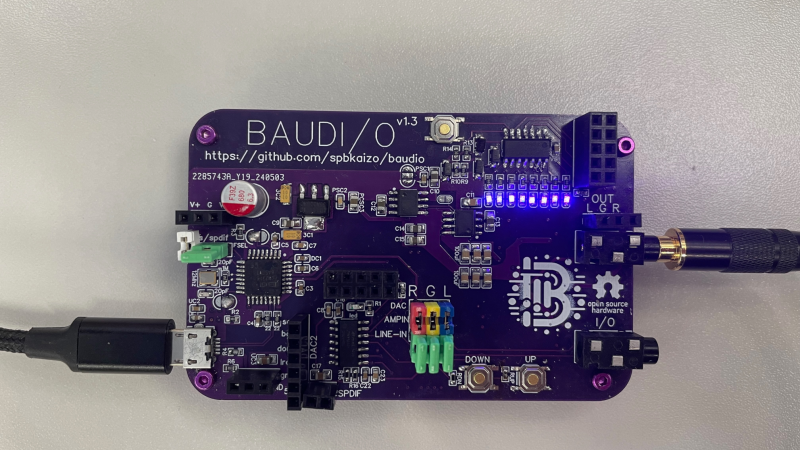[Simon B] enters our 2024 Business Card Challenge with BAUDI/O, a genuinely useful audio output device. The device is based around the PCM2706 DAC, which handles all the USB interfacing and audio stack for you, needing only a reference crystal and the usual sprinkling of passives. This isn’t just a DAC board, though; it’s more of an audio experimentation tool with two microcontrollers to play with.
The first ATTiny AT1614 is hooked up to a simple LED vu-meter, and the second is connected to the onboard AD5252 digipot, which together allows one to custom program the response to the digital inputs to suit the user. The power supply is taken from the USB connection. A pair of ganged LM2663 charge-pump inverters allow inversion of the 5V rail to provide the necessary -5 V for the output amplifiers. This is then fed to the LM4562-based CMoy-type headphone amplifier. This design has a few extra stages, so with a bit of soldering, you can adjust the output filtering to suit. An LM1117 derives 3.3 V from the USB input to provide another power rail, mostly for the DAC.
There’s not much more to say other than this is a nice, clean audio design, with everything broken out so you can tinker with it and get exactly the audio experience you want.

















Sorry i fail to understand how useful it as as a “audio experimentation tool”.
The AT1614 used as VU-meter ?
Or the second micro used to control the input level ?
It’ s just a plain USB soundcard….
So one experimentation part of it is that you can chain another DAC via i2s or spdif if you want an easy way to hook up one to the chain, via the i2s and spdif breakout. Or whack an LED on the SPDIF and shovel it into an input on another device, or hook it all up to a scope to learn about digital audio signals.
Next you have an attiny which exposes 10 pins including i2c on the volume control, so you can implement remote control via IR or whatever you wanted, gestures, motion sensors, etc. Movement activated audio anyone ?
The cmoy stage is documented heavily on the github pages, allowing experimentation with gain settings, HPF, etc. There’s also no reason to follow the suggested op-amp choice, so for those that like op-amp rolling they can play – gives an oportunity to test out various combinations of first and second stage op-amp models and vendors.
The second attiny is hooked up to the hot signal line, which lets you experiment with ADC sampling, or driving an external LCD display with a VU meter. By having two of them, you can take the output of one as the input to the first, making it self-controlling volume limiter.
So it’s designed so that you can build it into stages – if you just want to play around with a headphone amplifier, you can, skipping the DAC part and the volume control, and the second stage amplifier on the output.
You can also use it as a simple line-in, by toggling the jumpers on the board, if you wanted to focus on how the LPF/HPF filters work.
+1
I think a “audio experimentation tool” must have at least one powerful microcontroller (or/and DSP/FPGA) for audio data processing
“Page Not Found”
500 Something Went Wrong
But we are working on it!
A high sample rate microphone might have been a useful addition.